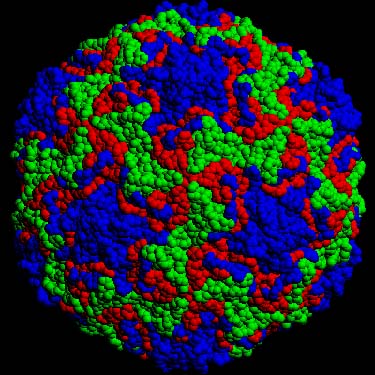
Plate 3b: Icoshahedral symmetry
 Plate 3b: b. Enormous symmetry allows one to specify elaborate structures using simple components, a feature viral DNA (or RNA) exploits.
Plate 3b: b. Enormous symmetry allows one to specify elaborate structures using simple components, a feature viral DNA (or RNA) exploits.
Shown here is a virus for the common cold. Note the similarity to the origami dodecahedra in Plate 3a!
More about this image
According to Michael G. Rossmann, Hanley Professor of Biological Sciences at Purdue University, this represents "a picture of human rhino virus (serotype 14) (common cold virus) ... The blue, green and red colours represent the surface of viral proteins (VP) VP1, VP2 and VP3, respectively. The individual balls correspond to specific amino acids. No doubt you realize that the symmetry of this and many other viruses is icosahedral."
The image is based on coordinates computed in 1985 in Rossmann's lab at Purdue and referenced in Rossmann et al. Nature 1985, 317, 145-153: its use requires prior authorization from Michael Rossmann.